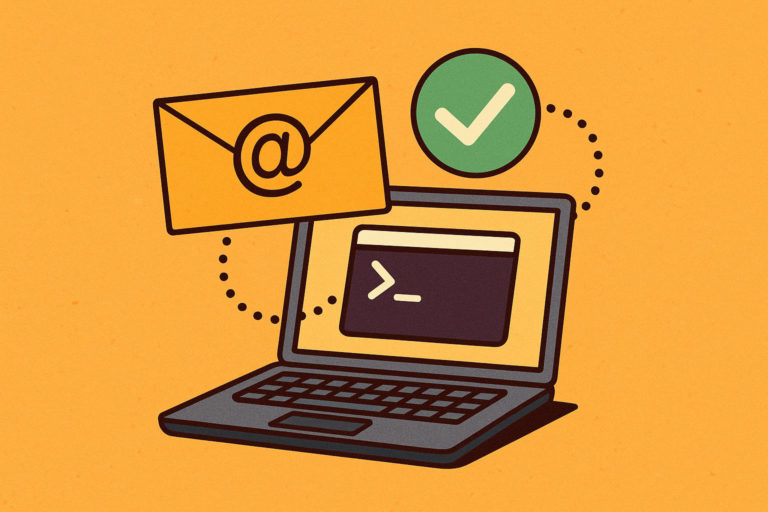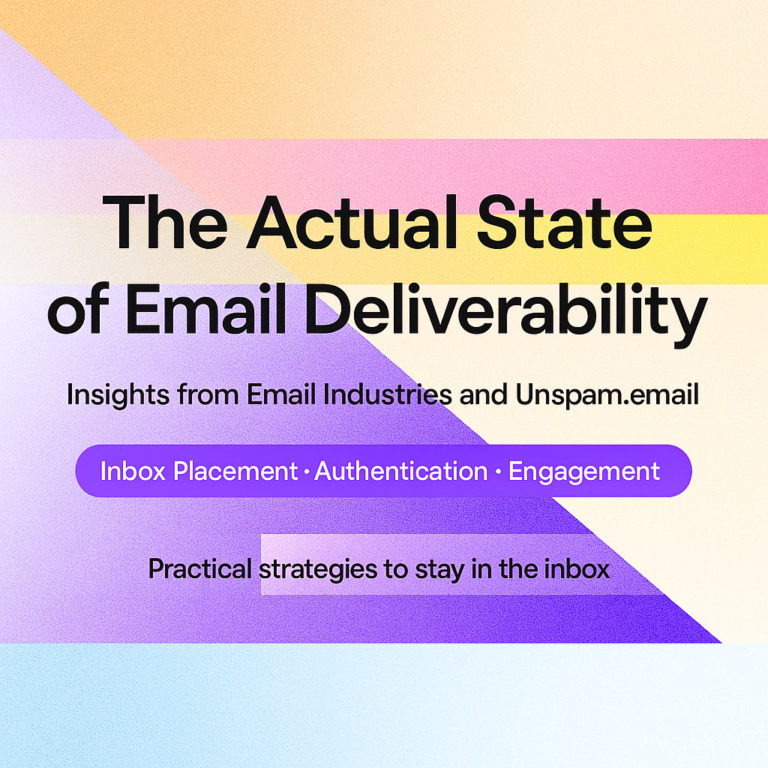Do you know that almost 50% of business emails are spam? Due to the increased level of cyber-attacks, email channels have been reinforced with stringent measures by mailbox filters and blacklist vendors to protect users from “uninvited guests.” Getting blacklisted can significantly impact your email deliverability, making it crucial to understand the process of email blacklist removal.
While it has increased communication safety, it has created substantial obstacles for companies communicating with their customers through digital correspondence. The latest stats show that your chances of being blocked by filters are increasingly high. Even if you do not intend any harm and put your heart and soul into email campaigns, your messages still might be turned down.
Many reasons lead to email rejection. It could be an occasional typo, full inbox, or spam word in a subject line – these causes are easily fixed without any aftermath. However, when it comes to blacklisting, things are quickly getting serious.
Blacklist vendors are kryptonite to email campaigns and newsletters. Playing by their rules and offering cardinal ways to fight spam and cyber-attacks, they may not just ruin one campaign, negating all of the work that went into it, but pause and even halt your presence in email channels for a long time.
The good news is blacklisting has a solution – companies may order email blacklist removal and get back on track. Acting fast, they may avoid consequences and proceed with their strategy without losing customers or ruining their reputation. Dive into our guide on how to remove your email from the blacklist to understand the basic steps of the routine.
First things first: What are blacklists, and why is it important to file email blacklist removal as fast as possible?
What Are Email Blacklists?
An email blacklist or Domain Name System-based Blackhole List or Real-time Blackhole List is a collection of IP addresses or domains considered untrustworthy due to their malicious activity, such as sending spam. They were caught by security companies or flagged by mailbox spam filters. The database is regularly updated and revised to stay up-to-date.
Email blacklists come in two types: domain name-based and sender’s IP address-based. Each one aims to keep user inboxes clean and valuable and protect email channels by fighting cyber-attacks and preventing unwanted spam content.
Mailbox providers, Internet Service Providers (ISP), and Anti-Spam Agencies (ASA) refer to email blacklists to decide the fate of the incoming email. For instance, Google uses blacklist data to identify addresses that should be sent to the spam folder or blocked right away.
Types of Blacklists
There are over 300 email blacklists on the web. They fall into three categories: public, private, and enterprise spam firewalls.
Public email blacklists are non-commercial projects that collect suspicious IPs or domains. They give unrestricted access to anyone who needs that, from email marketers to corporations to security vendors. Spamhaus, Project Honey Pot, and Spamcop are popular representatives in this category.
Private email blacklists are the same, but they are closed from the public, so outsiders (like email marketers or security vendors) cannot access them. Usually, popular mailbox providers like Google maintain them to improve their filtering and spam-recognition systems.
Enterprise spam firewalls are respected organizations in the cyber security niche. Barracuda, McAfee, and Cisco are famous representatives of this category. They also uphold records of domains and IP addresses caught in suspicious activity. Email marketers and big players in email channels rely on information provided by these spam firewalls.
Blacklist vendors offer crucial information for mailboxes and ISPs, but present a security barrier for email marketers. If companies fail to pass them, they might face some drastic consequences. Let’s consider the reasons that might lead them to this fate.
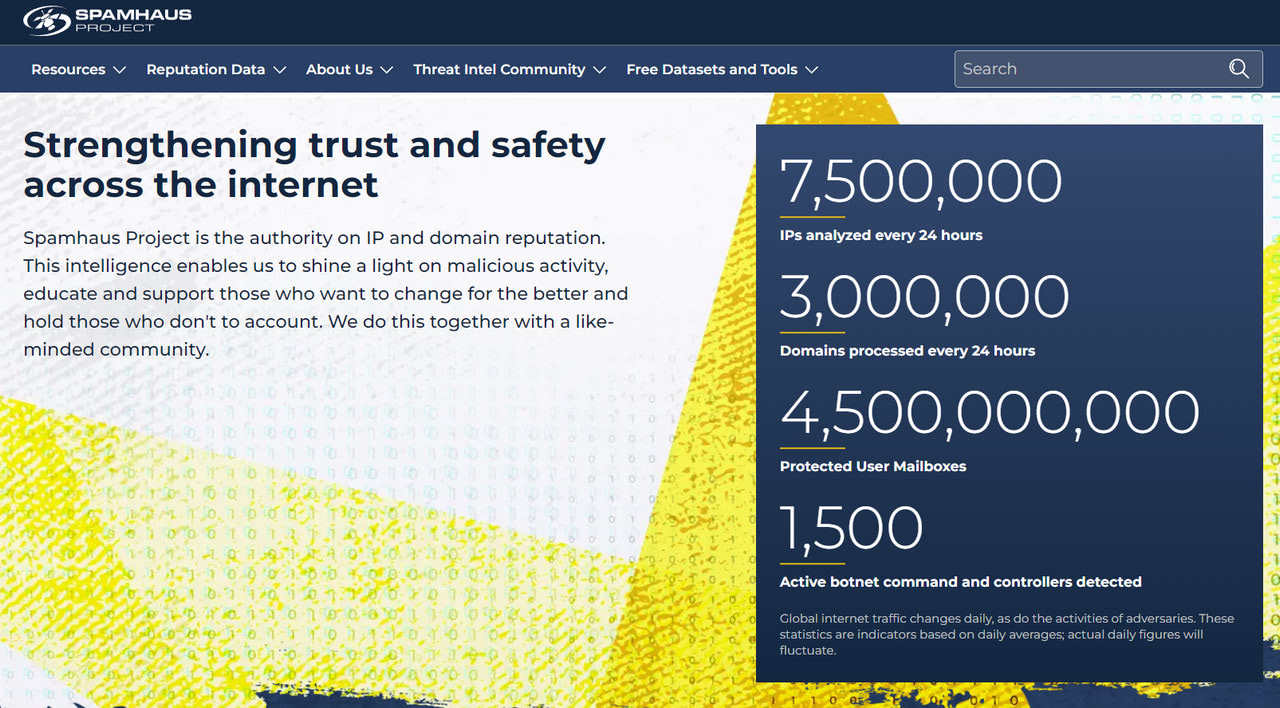
Reasons to Be Blacklisted
Email blacklist providers stick to their routine of detecting and listing malicious IP addresses and domains. They differ in their algorithms and security flowcharts. However, most of them base their decisions on some common reasons. This provides companies with insights into what might cause blacklisting and gives them knowledge of how to behave to stay on the safe side.
Let’s consider some popular reasons that lead brands to blacklist territory:
Poorly Configured Email Server
Every aspect of the company’s presence in the email channel matters for blacklist providers. The technical side is no exception. They take authentication seriously, making it their top priority when checking emails.
Such protocols as SPF, DKIM, and DMARC must be set correctly. These protocols were developed to ensure the company’s credibility and protect them from spoofing. If something is wrong with them, this is a serious ground for blacklisting and a red flag for every player in a channel.
Poor Website Security
Website security is one of the most critical aspects of a brand’s web presence. When it is poorly done, it may lead to drastic outcomes. For instance, companies risk becoming hosts for phishing scams if they do not use an SSL certificate, two-factor authentication, or third-party software to fight hackers and prevent cyber-attacks.
Blacklist providers know that perfectly. Therefore, they keep a close eye on web platforms with poor security and list them at first suspicion.
Another popular technical reason is to use a shared server instead of a dedicated one. While this may seem like a good investment for startups, it can easily become a trap when used by multiple users since you depend on your neighbor’s activity.
As blacklist vendors record IP addresses, not brand names, their decision to blacklist affects everyone related to it. If one of the websites in your network is identified as a spammer, you also suffer the consequences.
Increase in Outbound Emails
A sudden increase in outbound email is a sign of an IP address or domain being hacked or a company using a purchased list of subscribers. Both scenarios are considered to be bad in the email channel. They set off an alert to all integral players in the area, demonstrating potential spam movement.
Sadly, from a marketing point of view, this could happen to anyone from startups that bombard their subscribers without warming up to big companies that increase the number of their outbound emails during sales seasons. While they might not be listed by blacklist vendors right away, they still get under the radar.
Spam Traps
Spam traps (or so-called honeypots) are email addresses. Some were legitimate at one time, while others were invented on purpose. They fall into three main categories: pristine spam traps, recycled spam traps, and spam traps with typos.
Whatever the case is, these contact addresses are invalid now. Internet Service Providers and blacklist operators use them to identify email marketers who are not following the best email practices and exercise grey methods in acquiring subscribers.
For instance, pristine spam traps are generally hidden inside the code of public websites. Companies should use special software that crawls websites and collects contacts to access them. That means they do not ask their subscribers for consent to be on their subscription list.
Another case scenario is when companies have poor email list hygiene. Keeping non-existent subscribers or those not interested in the brand may lead to high soft and hard bounce rates and spam complaint rates. This is a signal for blacklist vendors that a company does not care about its subscribers.
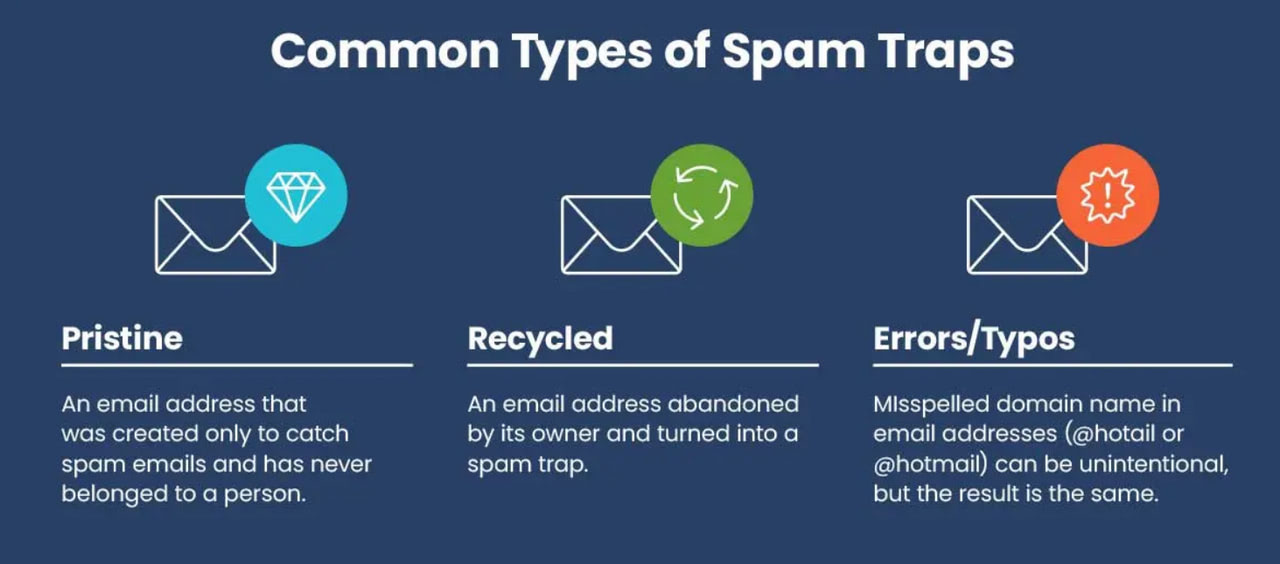
Common Types of Spam Traps by GetResponse
How Can Linking to Disreputable Websites Affect Your Email Deliverability?
When sending emails, the links you include are more than just navigation tools; they’re vital components that can influence whether your email reaches the inbox or ends up in the spam folder. Linking to questionable websites or using suspicious link-shortening services can harm your email deliverability in several ways.
Potential Risks of Linking to Shady Sites:
- Triggering Security Filters: Email providers like Gmail and Outlook use advanced algorithms to scan emails for signs of spam or malicious content. Links to disreputable websites can trigger these filters, flagging your email as suspicious and potentially landing it in the spam folder.
- Reputation Damage: Your domain’s reputation is crucial in determining whether your emails are seen as trustworthy. By associating your emails with low-quality or harmful websites, you risk damaging this reputation, making it difficult for future emails to bypass spam filters.
- Blacklist Consequences: Persistently linking to bad websites can lead to blacklisting by security providers. Once on a blacklist, emails from your domain may be blocked entirely across various platforms, severely limiting your ability to reach your audience.
- User Distrust: Even if your email makes it to the inbox, recipients may be wary of clicking on links that appear untrustworthy. This can lead to decreased engagement and lower conversion rates, ultimately undermining your marketing efforts.
To protect your email deliverability, ensure that all links point to reputable websites. Avoid link shorteners when possible, and regularly check the status of linked pages to maintain their credibility. By doing so, you enhance both your deliverability rates and the trust recipients place in your communications.
Importance of Quick Email Blacklist Removal
The importance of quick email blacklist removal lies in the way how blacklisting affects your business. Like it or not, companies have to face the aftermath of their ill-considered actions, the wrong approach to sending emails at scale, or a lack of knowledge or experience. Every leading vendor in the niche, like Barracuda or Spamhaus, brings damaging consequences for businesses.
However, how bad is bad to get into an email blacklist? Let’s consider several popular scenarios that companies might experience.
First of all, if the leading vendor blacklists a brand, it might stop its activity in the email channel completely. That means their emails, whatever valuable, never reach the subscribers’ inboxes. To make matters worse, nobody notifies them about that. Not only will their initial efforts and investments be in vain, but all future ones.
Second, being blacklisted affects delivery and deliverability rates dramatically. These factors describe the health of email communication, practices, and customer relationships. They are closely related to critical aspects such as open rates, conversions, and leads. The lower the deliverability rate, the lesser the effect of your email campaign.
There is more. Low deliverability affects the sender’s reputation. The latter makes the difference between your business thriving and floundering. For instance, with a low senders’ reputation, even your transactional emails, like confirmation emails, might be rejected by ESPs. That means you may experience delays in your business’ overall transaction process.
Third, with blacklisting, companies lose access to their long-time customers. Without getting valuable content, including special discounts, bonuses, or rewards, from their preferred brands, the target audience starts to seek alternatives, doubting their loyalty and commitment. That leads to decreased customer engagement, a declining subscription list, and ipso facto lower conversions and revenue.
Fourth, blacklisted companies are cut off from new customers. If your domain is blacklisted, you will not have access to new leads on your website. The absence of new leads means a poor fan base and an eventual decrease in revenue.
Finally, blacklisting signals to many organizations on the web that the brand is not trustworthy. Companies are not eager to partner with such a brand. That results in missed business and sales opportunities.
To sum up, the consequences of blacklisting vary from minor to severe. However, whatever the case, the company risks facing the aftermath that may ruin its presence in the email channels and undermine its overall marketing strategy. It is crucial to act fast and ask for email blacklist removal as soon as possible to secure the brand’s progress, maintain market positioning, protect relationships with customers, and save investments and revenue necessary to move forward.
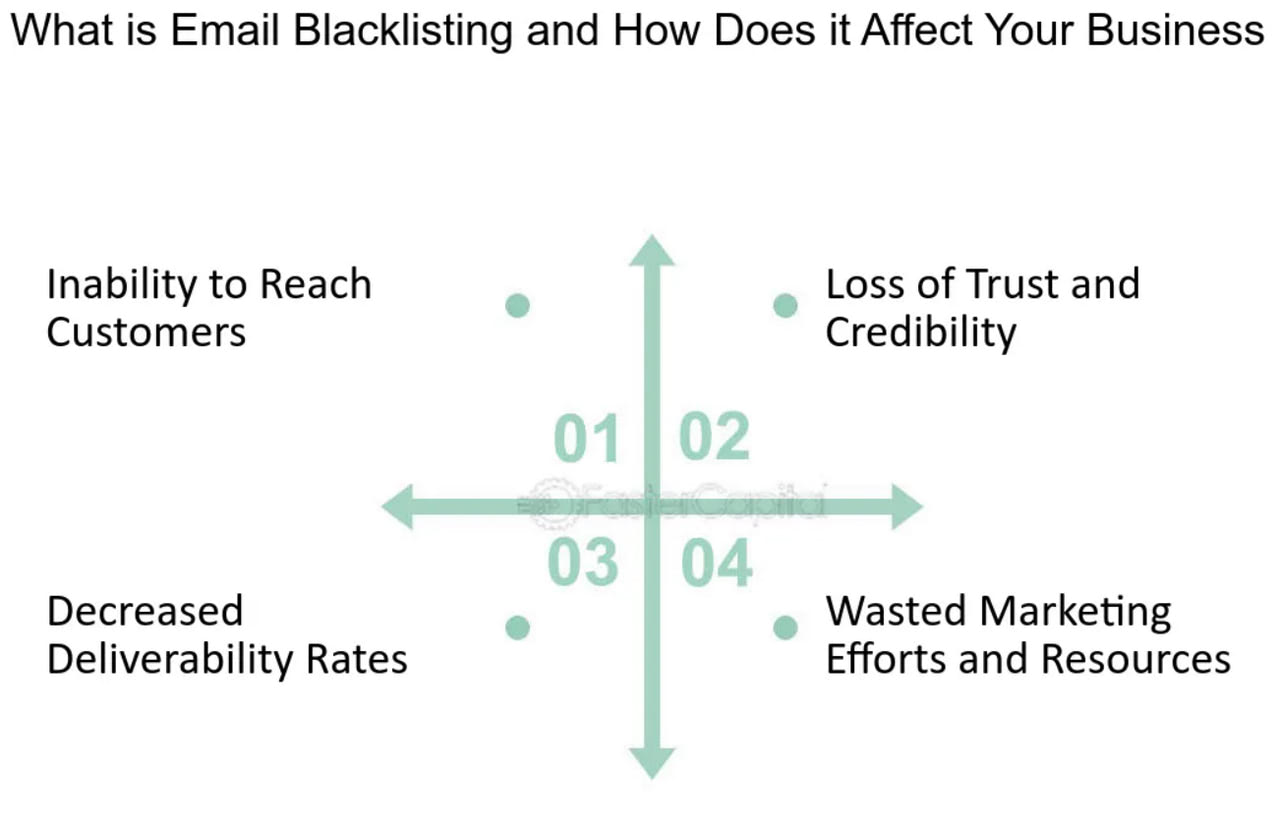
Email blacklisting aftermath by FasterCapital
Signs of Being Blacklisted
Do you know that nobody notifies you about being blacklisted? Security organizations do their job “silently.” However, consequences for your business could be pretty “loud.” How to avoid them? Learn to recognize the first signs of getting into their territory. Here are some clues.
One of the first signs that you have been blacklisted is a drop in email delivery and deliverability rates. Describing how many emails have reached the destination, these two factors first suffer the consequences of emails being rejected. Therefore, if something is wrong with them, it is time to look up blacklists.
Another sign is the increased number of hard and soft bounce rates. Many respected mailboxes decide the fate of your email based on information from blacklists. If you are on the list, especially in the one provided by the industry leaders, your chances of rejection are increasingly high. Therefore, your messages cannot be delivered, and they bounce back.
An increased spam rate is another sign of being blacklisted. Since mailbox providers have their own algorithms, they do not necessarily turn down your messages. Some may let your message in but put it in the spam folder, flagging it as spacious based on information acquired from the blacklist.
Drop in overall engagement. Overall engagement that could be assessed through such factors as open rates, click-through rates, conversions, and leads may also indicate blacklisting. Drop in these key performance indicators might mean your messages do not reach your subscriber’s primary inbox. Instead, they have been put into a spam folder.
Tracking KPIs, bounces, and deliverability is one way to detect the first signs of getting blacklisted. Another way is to seek these signs inside the email server’s log and mailbox error logs. They might feature a wealth of useful information that gives hints about early problems in email channel health and possible causes for blacklisting. For instance, some SMTP error codes in bounce-back emails offer insights into the blacklisting reasons.
Lastly, it should be noted that some internet service providers and mailbox providers, like Google, for instance, may notify you that you got blacklisted. Therefore, keeping a close eye on their messages is also crucial.
How To Run an Email Blacklist Check?
Without a definite sign of being blocked, it is almost impossible to know for sure if you have been blacklisted. Companies are almost blindsided here. Therefore, if you see some of the signs featured above, it is better to do a thorough email blacklist check to eliminate all suspicions or initiate an email blacklist removal procedure immediately to avoid bad consequences.
How to run an email blacklist check? You have two options: manual and automatic. If your company is small and you have plenty of time, you may do it the old way – manually. Here is a basic two-step routine:
Manual Checkup
Step 1 – Decide on What Blacklist Providers to Check
Blacklist providers come in all shapes and sizes and, most importantly, have different consequences on business. For instance, small private databases may have a small impact on you, while niche leaders may easily cut off your presence in the email channel at night. Therefore, it is highly recommended to start with the big players. This includes the following:
- Spamhaus Check – It collects malicious IPs and domains.
- Unspam – Show the list of blacklisted services.
- Microsoft – It has a blocked senders list. Since the system sends a non-delivery report to notify about blacklisting, it is crucial to check out the error log or your inbox.
- Proofpoint IP Lookup – It is a machine-learning system that collects IP addresses and malicious emails.
- Barracuda Lookup – It maintains a history of IP and the sender’s reputation to decide on the email’s health and status based on previous activity.
- Cisco – It collects email and spam data to define IP, domain, and file reputation.
- Spamcop – It gathers IP addresses known for transmitting spam or unwanted emails.
- SURBL – It specializes in collecting reputation data.
After that, you may also check some popular ISPs and mailbox providers, including Comcast, EarthLink, Verizon, Google, and Yahoo.
Step 2 – Do a Manual Lookup
The databases featured above have simple lookup tools. They can be easily found on their official websites. Therefore, visit the links above, find the form, enter the IP address or domain name, and click the button to run a search.
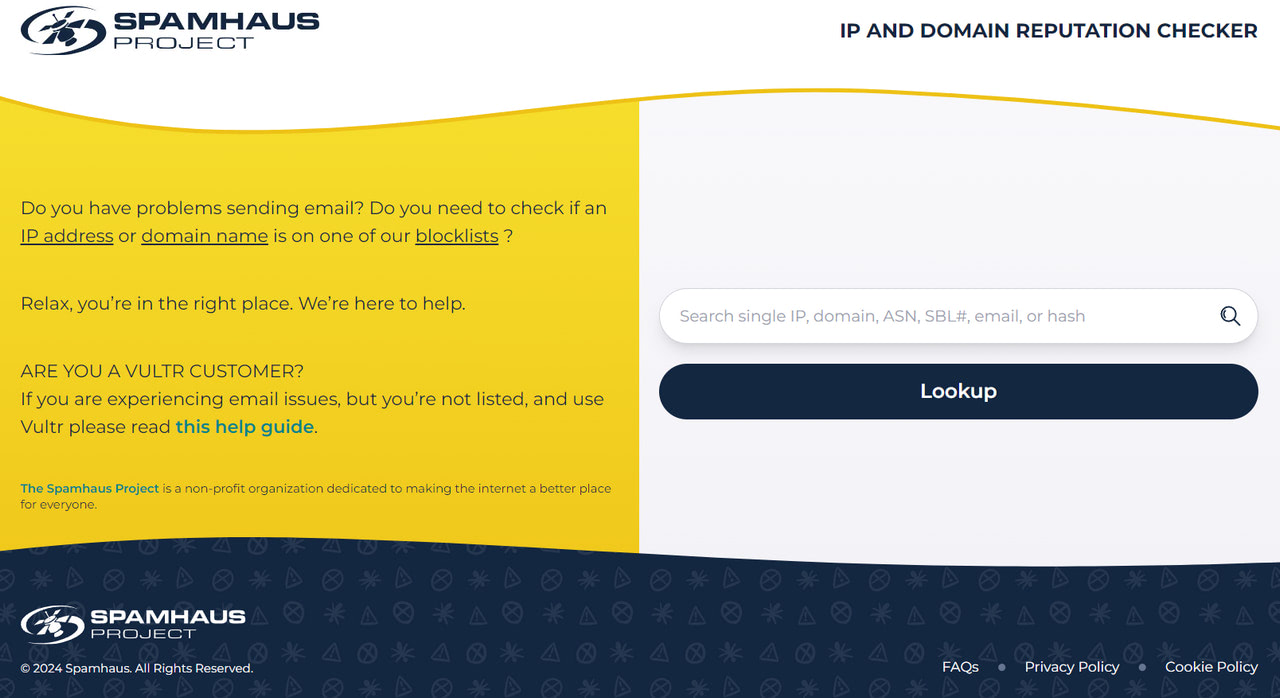
Automatic Checkup: Tools to Run an Email Blacklist Check
Checking your email blacklisting in the top RBL services could not be enough to come clean. There are over 300 vendors on the internet that might affect your email presence to a certain degree. Covering the biggest part is crucial to regaining your privileges in the email channel.
However, manually checking all of them takes lots of time and is not practically possible. If you want to do a thorough inspection of IP and domain reputation, you should use automatic diagnostic tools for email blacklist checks. They let you inspect the majority of blacklist vendors in minutes, giving you real-time data about the health of your IP and domain.
On top of that, some of them offer features to discover more information about your email address, its status, the sender’s reputation, and deliverability. They might even show your email content and design in the eyes of the mailboxes and internet service providers. Consider these two popular options to see what they can do for you:
Unspam
Unspam is a strong representative of diagnostic tools in the niche. Not only does it perform a comprehensive blacklist checkup, but it also offers a broad set of tools to troubleshoot, analyze, and improve email-related issues.
Coming with an intuitive interface, it allows everyone to test a mail server IP address against popular email blacklist vendors without any special skills or knowledge. It works fast and efficiently, saving you precious time.
Apart from that, it inspects the validity of a technical side by going through SPF, DKIM, and DMARC authentication records. It also calculates your inbox placement, details key factors of your email campaign, design, and content, and even provides valid insights on improving the deliverability rate based on your sender’s reputation.
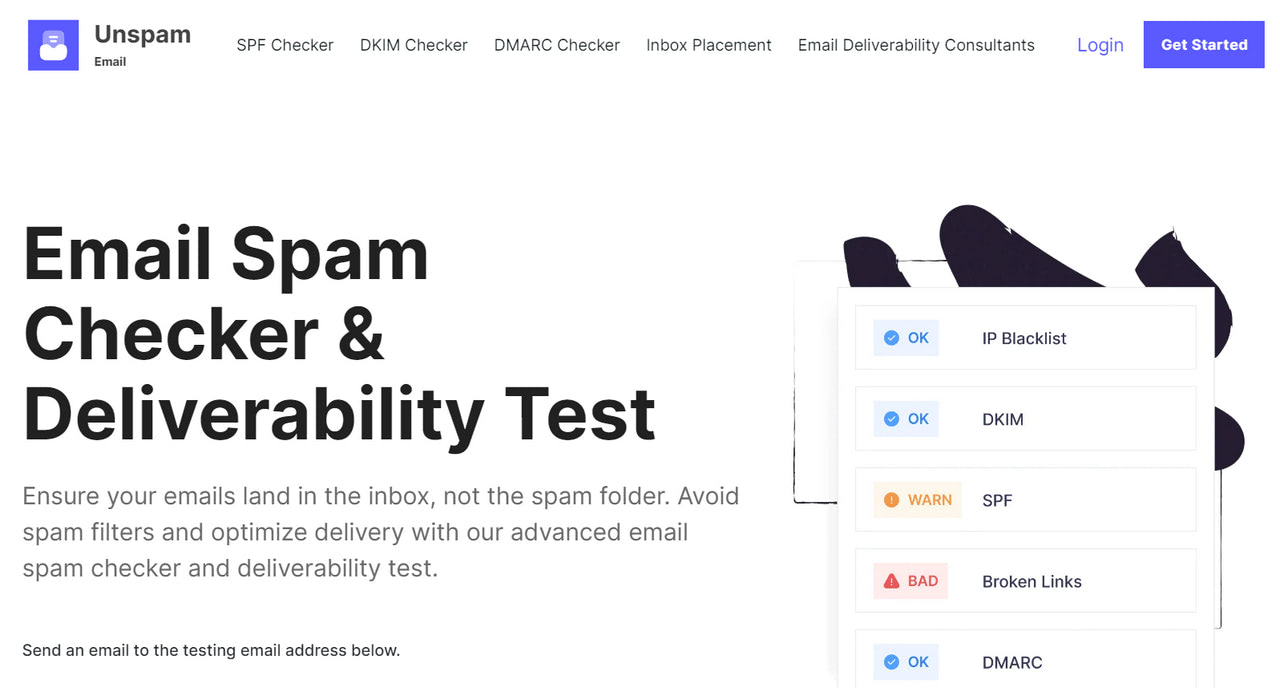
MXToolBox
MXToolBox is one of the oldest yet popular instruments in the niche. Its interface might look a bit outdated and raw, but it does what it should – run a thorough check against 100 DNS-based email blacklists, coming as a simple yet reliable solution for companies across the Globe.
Focused on email servers, DNS records, and email delivery, the service works with both IP addresses and domain names, providing businesses with crucial information about their status in blacklist databases.
Premium users may benefit from their extra functionality that helps to identify and resolve issues related to email delivery, spam filtering, DNS configuration, and overall email server health.
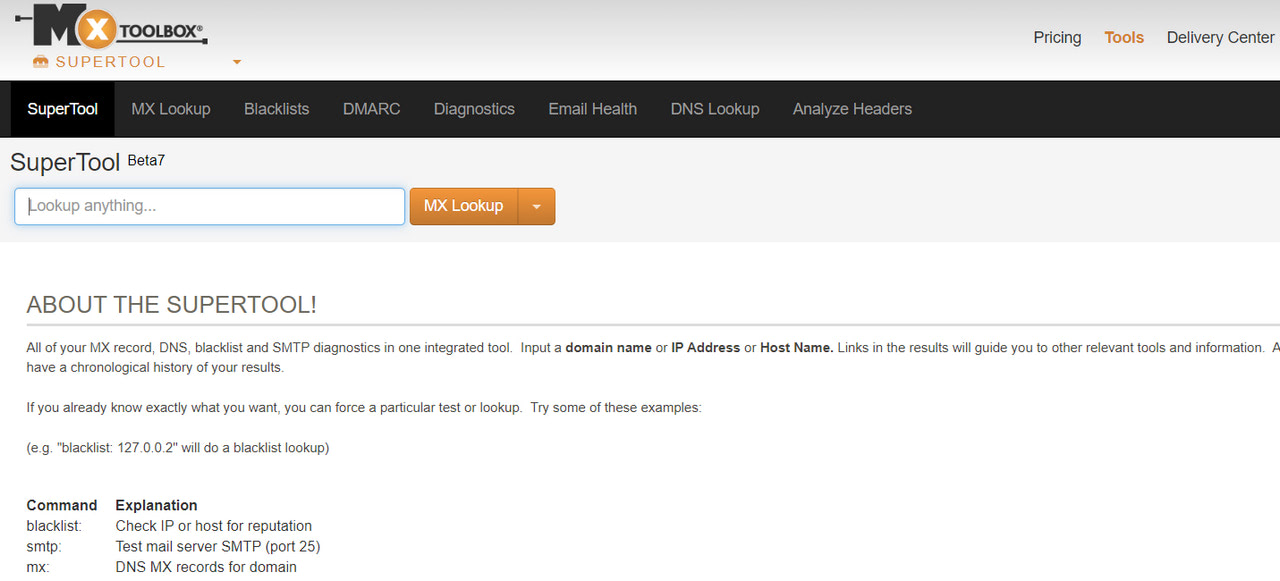
You may also consider such professional automatic blacklist checkup instruments as IP Blacklist Checker and SenderScore.
Step-by-Step Guide to Remove Your Email from Blacklists
Ending up on an email blacklist is a common scenario that might happen even to the best of us. According to studies, 15% of the email marketers had been blacklisted at least once in the last year.
The good news is that it is not the end of the World, though it certainly may halt your activity in email channels or nullify your efforts in building a strong brand reputation. If you have found out that your email address has been blacklisted, you need to act quickly. Fast email blacklist removal helps to avoid consequences and lets you move toward your email marketing goals.
So, what do you need to do? Consider this detailed email blacklist removal procedure.
Figure Out All Blacklist Vendors that Have You
Before moving to a delisting routine, it is crucial to get a thorough understanding of your problem. If you are blacklisted by one of the industry leaders, chances are you are already on the list of some others. It is crucial to run a thorough blacklist check to define providers you need to deal with to regain your reputation in the email channel.
Therefore, open Unspam or any professional platform of your choice and run a thorough lookup against all popular blacklist vendors. Check out not only your IP but also your domain to assess the severity of the situation.
Start with Industry Leaders
Consequences of blacklisting vary depending on the vendor that has caught you. Since time is a critical factor in email channels, and you need to act as fast as possible, starting with big players that may affect you the most is preferable. Prioritizing niche leaders is also a great way to minimize the aftermath and even sort out issues with less popular providers beforehand since they may have you for similar reasons.
With that said, do not neglect small blacklist vendors. Although they might not impact your email activity profoundly, they may still ruin it in the long run. Plus, when inspecting them, you might get helpful insights on potential problems in the health of your email communication or early signs for blacklisting. After all, if you do delisting, it is crucial to come 100 percent clean.
Here are popular blacklist vendors that you need to focus on first: Composite Blocking List and Spamhaus Block List by Spamhaus, Spamcop, Passive Spam Block List, Invaluement, Barracuda, SURBL, and Cisco Talos Intelligence.
Automatic Delisting by ESPs
Many reputable email service providers take care of their client’s delisting. They contact their customers and guide them through getting the problem fixed by giving recommendations. When all adjustments are made on the client’s side, they reach out to the blacklisting services to get clients removed from databases. If you have such ESP, contact the team and follow their instructions.
However, what should you do if you are alone or your ESP does not provide this functionality?
Well, you might be lucky by being caught by blacklist vendors that practice time-based removal. That means they automatically delist lower-level IPs (light offenders) in a certain period. Usually, it takes a week or two to get out of their databases; though, this period could be longer if the IP address had sent spam more than once or at a high volume.
If you are not so lucky with automatic email blacklist removal, it is crucial to initiate a manual delisting procedure.
Manual Delisting
Diagnose the Problem
Being caught by a regular email blacklist operator is a popular case for many companies. It is here where they need to do manual delisting by asking for email blacklist removal. However, before doing this, they must eliminate the reasons they were originally caught.
Narrowing down all issues with your communication in the email channel is crucial. First of all, if you do not do that, a blacklist provider will reject your request.
Second, if you are successful with delisting but the small problem remains, you risk to get blacklisting again. The more often you are caught by blacklist providers, the more challenging it will be to get out, maintain a strong presence in email channels and build a good sender reputation. You may even risk your domain being blocked permanently – the only way out would be to get a new one.
Third, dealing with problems helps you to create a detailed report necessary for some leading blacklist services. Therefore, take your time and thoroughly examine the root of the problem.
Reasons for blacklisting may vary: it could be technical, marketing-based, or compliance-based. Where to start? Here are some clues on what you should do first to locate an issue:
- Audit error logs. Error logs are the perfect place to find insights into problems with your email communication. Some ISPs and mailbox providers may even notify you about that.
- Inspect email authentication. This is the most critical technical part of the email. Everything should be in place and correctly set out. This includes Sender Policy Framework, DomainKeys Identified Mail, and Domain-based Message Authentication, Reporting, and Conformance. If you doubt these records and settings, you might use Unspam or other tools to check their validity.
- Scan server infrastructure and security measures. Use professional software to check your server against viruses and malicious code. Ensure your security measures are up-to-date and strong to protect against potential cyber-attacks and hacks.
- Examine Feedback Loops. As anything, high complaint and spam rates are one of the most popular reasons to be blacklisted. Read complaints and history logs to address the reasons.
If you still cannot find the main reason, you should inspect blacklist providers’ specific recommendations and check your email presence and infrastructure according to their factors.
On top of that, it is crucial to go through your email marketing strategy and practices. This area is big. Start with ensuring your emails comply with all anti-spam regulations and laws. As you acquire more subscribers on board, it gets tricky to consider all local regulations and laws. However, it must be done.
Then, revise your subscription list to make it clean. Afterward, inspect permission-based email marketing practices. It would also help to review cadency and communication modes with subscribers. Do you send generic emails? Do you bombard them at every opportunity?
Finally, assess the quality of your email content and design. Does your email look and behave coherently across devices, screen sizes, and email readers? Do you deliver value with every message?
Ask for Email Blacklist Removal
After locating and fixing the problem, the time has come to ask for email blacklist removal. Depending on the vendor, you may send a simple request, contact the team personally, or even provide a detailed report of actions that have been taken. Whatever the case, it is important to do this step cautiously to meet all the requirements and eliminate possible confusion in communication.
In addition, you need to provide detailed information about your company in the email channel. Most of the time, this includes the IP address, domain name, name of the company, contact information, and detailed description of the cause.
Here are some brief instructions on what you need to do with the industry leaders:
Spamhaus
Depending on the type of listing, you might adopt specific steps. Therefore, read their guide and recommendation carefully for each cause. Record your steps. Ensure to take preventive measures to avoid blacklisting again.
Barracuda
Provide information about the cause of blacklisting, actions taken to fix it, and a valid explanation. Submit the request to remove you from the blacklist.
Microsoft
Sign in to the system with your account. Fill out the form and describe how you have resolved the issue.
SpamCop
Although listing in SpamCop expires automatically, some companies may remain in their database. If your IP is still there, contacting the SpamCop team and resolving the listing is highly recommended.
SURBL
Define your listing type and act accordingly. Provide crucial information about your company. Ask for email blacklist removal through their form.
Proofpoint IP
Visit the PDR request removal page and open a request ticket. Enter your IP and fill out the form. Describe the situation and remedy in detail, and only then submit a request.
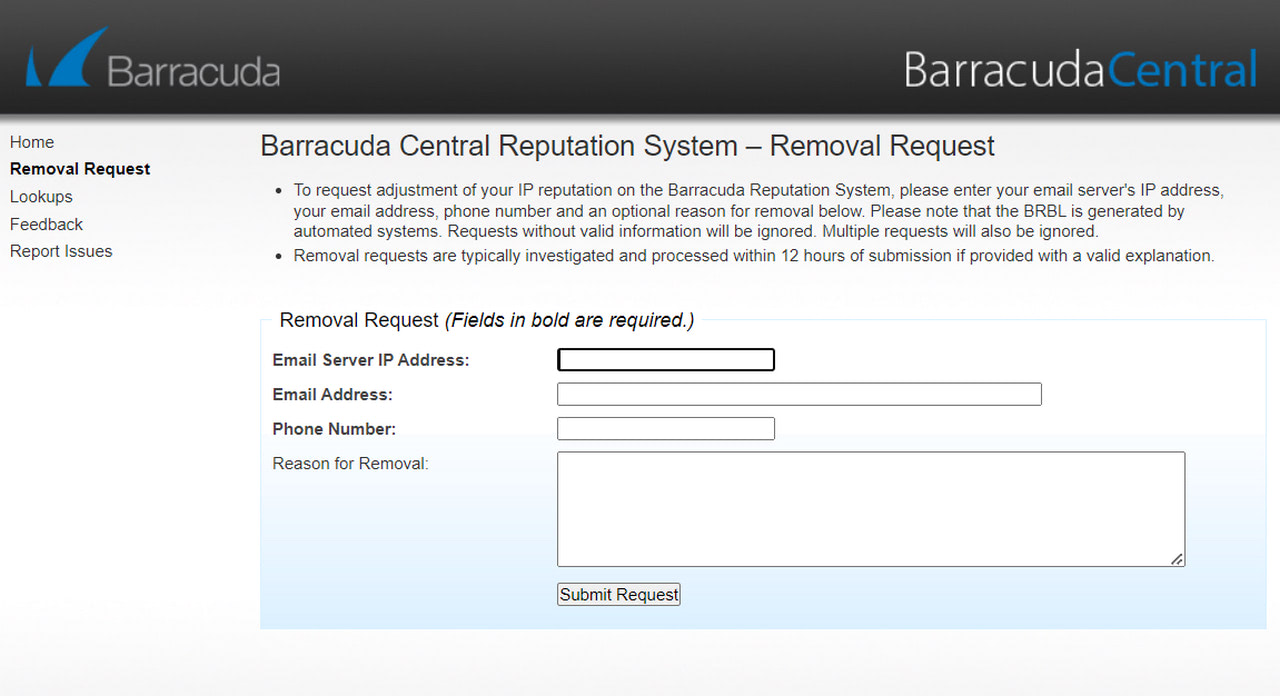
Email blacklist removal request in Barracuda
Monitor and Run the Lookup Test Again
Delisting takes time. Some companies do that in a week, while others make you wait for months. The period depends on many factors, such as the blacklist’s scale, the reason why you have been blacklisted, how well you have addressed the issue, the reviewing process, the current situation in the email channels, etc. Plus, some providers may require additional steps to be taken after requesting email blacklist removal. So, be patient, wait, and follow their guidelines.
On top of that, it is crucial to monitor your deliverability rate regularly and do the final lookup test again to ensure you are safe. Take your time even after the system has sent you an official notification. As a rule, updating the database and removing your record takes 24 to 48 hours.
Lastly, if a delisting request is turned down, there are two ways to deal with this situation.
First, you might appeal the decision. Review the feedback and reason for the rejection. Fix the problem and file for email blacklist removal again.
The second way out is to create a new domain or use another IP address. While it may require building your sender’s score from scratch, it could be a solution if you need to spend lots of resources to get delisted or the cause for which you have been delisted is too serious.
Take Preventive Measures
The sad truth about blacklisting is that it may happen again. To make matters worse, if you keep getting into such databases, you may ruin everything you have already built. The delisting process for repetitive companies can be tougher, more rigorous, resource-intensive, and time-consuming than for newcomers.
Therefore, reducing the chances of getting marked by email blacklists again is vital. The good news is all you need to do is to follow the rules, the instructions, and the terms and conditions provided by blacklist vendors. Adopt the recommended practices for your email development routine. Establish new rules for team members and educate everyone about the best practices in the niche. Check out our list of preventive measures to get a head start.
Best Practices Against Blacklists
The main culprit with email blacklists is that they do not follow one standard. Each service has its security flowchart to root out “bad” emails at different levels. But that does not mean you cannot play along with them.
Blacklist providers have one goal. They encourage companies and individual email marketers to create a safe place for users on the internet, particularly email channels, through their activity. They offer recommendations to help companies send emails responsibly.
Here is the list of the best practices approved by the majority of blacklist vendors. Adopt them in your email marketing routine to stay away from blacklist territory.
Build Your Subscription List Gradually
It is always tempting to double your subscription list at once and increase your target audience by purchasing subscribers’ contacts, especially when you are a startup. But this is a no-no practice.
Doing this, you violate privacy regulations and security laws set by CAN-SPAM and GDPR, to say nothing about disrespecting your customers. In addition, many purchased lists are rich in spam traps, invalid addresses, and old contacts. Therefore, build a healthy and clean subscription list by acquiring subscribers gradually using a two-step verification process.
Clean Subscription List Regularly
Along with building a quality subscription list, it is crucial to clean it regularly. According to studies, it declines naturally every year because customers change or abandon their email addresses. If you keep invalid contacts on the list, you risk increasing soft and bounce rates that might signal blacklisting vendors.
Therefore, clean a subscription list every half-year by using email validation tools. These professional instruments help you to check email addresses’ legitimacy and identify invalid, inactive, and temporary records. Depending on the type of contact, you can either include it in a re-engagement campaign or remove it immediately.
Ask Subscribers to “Whitelist” You
Some emails may automatically be routed to recipients’ spam or junk folders. This might even happen to big companies. One way to avoid this fate is to ask your subscribers politely to “whitelist” you.
“Whitelisting” an email implies that users approve you by moving your email into their primary inbox. This indicates to mailbox providers that users trust your brand and appreciate your communication.
Perfect the Technical Side
The technical side of your email communication is increasingly important for mailbox providers, ISPs, and blacklist vendors. If you do not have a digital signature or your DMARC record is incorrect, your email correspondence can be easily compromised, opening doors for cyber-attacks. Therefore, take the authentication process seriously and introduce these measures:
- Authenticate your IP addresses with SPF.
- Configure DKIM signatures for your messages.
- Protect your domain with DMARC authentication.
- Publish the BIMI record.
- Be consistent with sender addresses.
- Use human-friendly “from” names.
In addition, it is crucial to ensure the security of your server. If you use one of the leading ISPs, then you should not worry since the company does all the heavy lifting. However, if you run your server, it is crucial to protect it from malware or bots through professional software.
Do Not Act as a Spammer
If you do not want to be seen as a spammer, do not act like one. That means you should follow the best practices in running email campaigns, creating email designs, and, in particular, content. For instance, whatever tempting it might be, it is crucial to avoid spam trigger words like “Buy Now,” “Act Fast,” or “Limited Time Offer” in the subject line and email copy. Among other recommendations are:
- Make emails relevant to your target audience’s needs, preferences, and expectations.
- Create hyper-personalized and highly targeted messages.
- Do not reuse the same template again and again. Make communication diverse and rich.
- Bring value with every message.
- Increase engagement with your brand through different campaigns.
- Create responsive and mobile-friendly designs using professional tools like Postcards email builder.
- Nail formatting and avoid mistakes in email copy.
- Find the perfect cadency for your market segment.
- Give subscribers a clear option to unsubscribe from emails.
Verify your Subscription List and Emails
Real-time email verification is perhaps one of the best ways to avoid blacklists and, at the same time, improve deliverability, email content, and design. Done by professional automated tools, this step is a must-have for email campaigns regardless of size and scale. Not only does it perfect list hygiene, but it also saves the whole campaign from being wasted.
Therefore, introduce this step before deployment. You might use Unspam or similar services to verify emails, inspect deliverability, and get crucial insights into your email content and design performance.
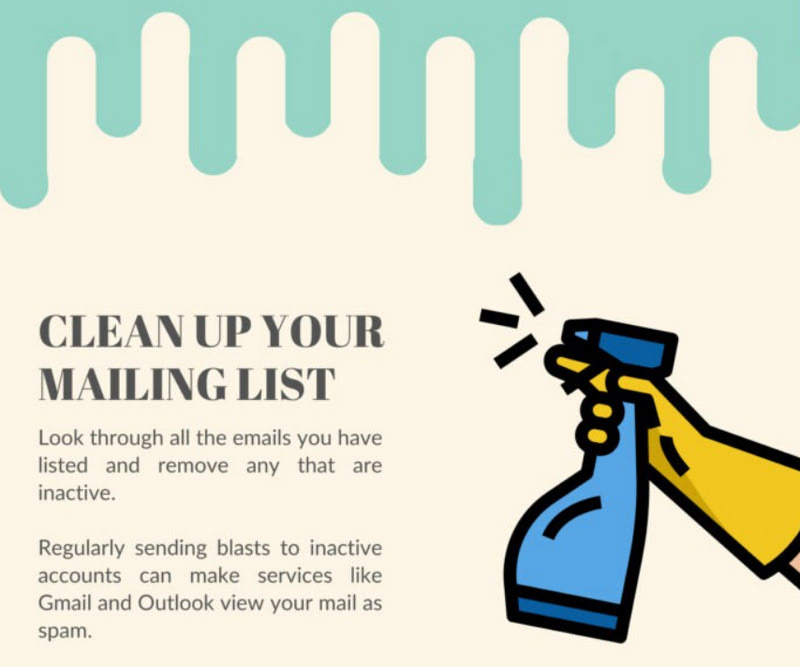
Visual snippet from “How to Avoid Email Spam Filters” infographic by Giraffe Social
What is the Benefit of Using Active Opt-Ins in Email Marketing?
Active opt-ins, commonly referred to as double opt-ins, offer a layer of protection and precision in building your email list. Unlike single opt-ins, which only require users to input their email address once, double opt-ins ask for an additional step: a confirmation from the subscriber. This ensures that the email provided is correct and that the individual genuinely wishes to receive your communications.
Why Choose Active Opt-Ins?
- Reduce Invalid Entries: By incorporating a second confirmation step, you significantly decrease the likelihood of fake or mistyped email addresses entering your database. This step helps maintain a clean and accurate email list.
- Improve Deliverability: With fewer bounced emails caused by incorrect addresses, your emails are more likely to reach their intended recipients. Better deliverability means higher engagement and effectiveness of your campaigns.
- Protect Your Reputation: A cleaner list leads to fewer spam complaints, helping preserve your sending reputation. A good reputation is crucial for ensuring your emails are not marked as spam by major email providers.
- Ensure Intentional Subscriptions: Only those truly interested in your content will complete the double opt-in process. This results in a more engaged audience, prone to higher conversion rates and interaction levels.
In conclusion, using active opt-ins provides a structured approach to building a high-quality email list. It’s about quality over quantity—ensuring that every email sent has the potential to engage and convert.
Conclusion
Blacklisting can turn into a dreadful scenario for many companies regardless of their size, age, product, and target audience. From decreased key performance indicators to diminishing the sender’s reputation to cutting off completely from the email arena, it could have a harsh aftermath on the company’s marketing activity and presence in the market. Understanding and following the process of email blacklist removal can help you restore your email reputation and improve the effectiveness of your email communications.
To make matters worse, discovering that your company has been blacklisted can be a total surprise. As blacklist vendors do not send notifications of this kind, companies should do manual or automatic checkups when they see the first signs of possible blacklisting.
The good news is getting blacklisted is not the end of the World. Companies may ask for email blacklist removal. This procedure requires narrowing down causes that have triggered blacklist filters, eliminating them through fixing email campaigns and infrastructure, and filing an official request. Depending on the blacklist provider, it may take time and even extra effort. However, it is the only way to come clean and regain your sender’s reputation in the email channel.


